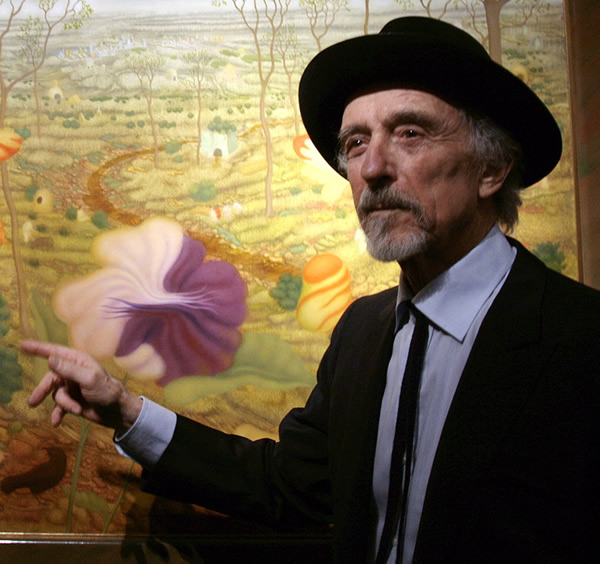Fantastic Realism
Austrian Art Movement finds a home in Vienna's Fantastic Art Museum
by Maggie-Gambill-Koebele
As one of the defining modern art movements of post-war Austria, Fantastic Realism has assumed an internationally recognized place in modern Western art. Founded in 1949 by a group known as the Vienna School of Fantastic Realism, the art form combines religious and esoteric symbolism with elements of psychoanalysis. Sharing an affinity to Surrealism and Magic Realism, its themes are characterized by subtle compositions of fantastic, imaginary creatures or human forms, often elongated or exaggerated, positioned in imaginative and complex poses.
 Arik Brauer in front of his painting "Elginat Egos". Photo: Manfred Werner
Arik Brauer in front of his painting "Elginat Egos". Photo: Manfred Werner
It’s unsettling and strange, sometimes depicting apocalyptic visions, cosmic dreams or erotic fantasies, painted in realistic fashion with a technical perfection mirroring that of Rembrandt. Initially overshadowed by Abstract Art and denounced by the Surrealists as an inferior imitator, it gained increasing acceptance in the latter half of the 20th century and most recently has witnessed a new rebirth of interest.
The Vienna School of Fantastic Realism was founded in the aftermath of WW II by a group of young Austrian artists who attended the Vienna Academy of Fine Arts. This group included Arik Brauer, Ernst Fuchs, Rudolf Hausner, Wolfgang Hutter, Fritz Janschka and Anton Lehmann, and their teacher and mentor was Albert Paris Gütersloh. As a student of Gustav Klimt and a professor he was forced into exile by the Nazis in 1938. Upon his return in 1945, he presided over the newly-founded Arts Club, which later gave rise to the Vienna School of Fantastic Realism. Considered one of the most progressive platforms for young artists, it fought for the autonomy of art.
As a tribute to the significance of these visionary artists, a new museum will be established in Vienna to exhibit their art. The Museum of Fantastic Art, housed in the Palais Pallfy, in January of 2011 will open with an exhibition on “Fantastic Realism.” The museum will span the history and trends of Fantastic Art from its beginnings – from the precursors (Franz Sedlacek and Alfred Kubin) to the contemporaries (Arnulf Rainer, Hundertwasser and Maria Lassnig), to those of the Vienna School. The Vienna visionaries (Kurt Regschek, Peter Proksch and De Es Schwertberger), will be represented as well as the so-called next generation of artists national and international. The museum will have an archive for researchers, host events and schedule tours. By creating an educational center it will exceed the services of most art museums.
As one of the co-founders of the Vienna School of Fantastic Realism, Franz Janschka will occupy an important place in the exhibition as a sustained presence in the international art scene. Today, at the age of 91, he continues to be a living legend of the movement. Born in 1919, Janschka entered Vienna’s Academy of Fine Arts in 1943, where together with student colleagues he contributed to the establishment of the new artistic movement.
Eager to expand his horizons, he accepted an opportunity to become an artist-in-residence at Bryn Mawr College in Pennsylvania, where he arrived in 1949 without any knowledge of English. Although he originally intended to stay just one year, he served as a professor of fine arts at the college for more than thirty years. At his home in Greensboro, North Carolina, he continues to pursue his life as painter, sculptor and graphic artist, employing vivid colors and decorative images of variations on the reoccurring theme of metamorphosis. His artwork has appeared in countless exhibitions held by renowned museums, including the Belvedere and Albertina in Vienna, the Art Institute of Chicago and the Philadelphia Art Museum.In honor of his lifetime achievements, the City of Vienna presented him with the Gold Medal of Merit in 1989.
